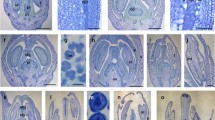Abstract
Morphological and cytological studies are complementary approaches to understand the molecular mechanisms that regulate floral developmental pathways. To better understand abnormal mutant phenotypes in floral development, we conducted detailed observations and investigations of the morphology, cytology, and cell ultrastructure of wild-type Chinese cabbage (Brassica campestris L. ssp. chinensis Makino and syn. B. rapa ssp. chinensis) flowers when they developed from primordia to anthesis. First, we measured bud and organ length with a stereo microscope and observed the developmental status and characteristics of the floral organs using a scanning electron microscope; then we made thin slices of anthers to observe the developmental stage and characteristics of pollen using an optical microscope; and finally, we made super-thin slices of anthers to observe the ultrastructure of pollen during its development with the aid of a transmission electron microscope. In this study, the floral developmental continuum was divided into 17 stages based on significant changes in the shape of floral primordia, and the pollen developmental continuum was divided into 14 stages based on the developmental characteristics. The results could provide the morphological basis for further research on the molecular mechanisms that regulate development of the floral organs and/or pollen of Chinese cabbage and their allied species.





Similar content being viewed by others
References
Bowman J (1994) Arabidopsis-an atlas of morphology and development. Springer-Verlag, London
Cao JS, Yu XL, Ye WZ, Lu G, Xiang X (2006) Functional analysis of a novel male fertility CYP86MF gene in Chinese cabbage (Brassica campestris L. ssp. chinensis Makino). Plant Cell Rep 24:715–723
Feng M, Lu A (1998) Floral organogenesis and its systematic significance of the genus Nandina (Berberidaceae). Acta Bot Sin 40:102–108
Fitzgerald MA, Knox RB (1995) Initiation of primexine in freeze-substituted microspores of Brassica campestris. Sex Plant Reprod 8:99–104
Hayward HE (1938) The structure of economic plants. Macmillan, New York
Hill JP, Lord EM (1989) Floral development in Arabidopsis thaliana: comparison of the wild type and the homeotic pistillata mutant. Can J Bot 67:2922–2936
Huang L, Cao J, Zhang Y, Ye Y (2007) Characterization of a novel gene, BcMF7 that is expressed preferentially in pollen of Brassica campestris L. ssp. chinensis Makino. Sci China Ser C Life Sci 50:497–504
Huang L, Cao J, Ye W, Liu T, Jiang L, Ye Y (2008a) Transcriptional differences between the male-sterile mutant bcms and wild-type Brassica campestris ssp. chinensis reveal genes related to pollen development. Plant Biol 10:342–355
Huang L, Cao J, Zhang A, Zhang Y, Ye Y (2008b) Characterization of BcMF10, a novel gene involved in the pollen wall development of Brassica rapa L. ssp. chinensis Makino. Funct Plant Biol 35:1194–1204
Huang L, Cao J, Zhang A, Ye Y, Zhang Y, Liu T (2009a) The polygalacturonase gene BcMF2 from Brassica campestris is associated with intine development. J Exp Bot 60:301–313
Huang L, Ye Y, Zhang Y, Zhang A, Liu T, Cao J (2009b) BcMF9, a novel polygalacturonase gene, is required for both Brassica campestris intine and exine formation. Ann Bot 104:1339–1351
Murgia M, Charzynska M, Rougier M, Cresti M (1991) Secretory tapetum of Brassica oleracea L.: polarity and ultrastructural features. Sex Plant Reprod 4:28–35
Nakayama N, Arroyo JM, Simorowski J, May B, Martienssen R, Irish VF (2005) Gene trap lines define domains of gene regulation in Arabidopsis petals and stamen. Plant Cell 17:1–21
Orr RA (1978) Inflorescence development in Brassica campestris L. Am J Bot 65:466–470
Owen HA, Makaroff CA (1995) Ultrastructure of microsporogenesis and microgametogenesis in Arabidopsis thaliana (L.) Heynh. ecotype Wassilewskija (Brassicaceae). Protoplasma 185:7–21
Pina C, Pinto F, Feijó J, Becker J (2005) Gene family analysis of the Arabidopsis pollen transcriptome reveals biological implications for cell growth, division control, and gene expression regulation. Plant Physiol 138:744–756
Polowick PL, Sawhney VK (1986) A scanning electron microscopic study on the initiation and development of floral organs of Brassica napus (cv Westar). Am J Bot 73:254–263
Polowick PL, Sawhney VK (1990) Microsporogenesis in a normal line and in the ogu cytoplasmic male-sterile line of Brassica napus. I: the influence of high temperatures. Sex Plant Reprod 3:263–276
Sattler R (1973) Organogenesis of flowers. University of Toronto Press, Toronto
Smyth DR, Bowman JL, Meyerowitz EM (1990) Early flower development in Arabídopsis. Plant Cell 2:755–767
Spurr RA (1969) A low viscosity epoxy resin embedding medium for electron microscopy. J Ultrastruct Res 26:3–43
Twell D (2002) Pollen developmental biology. In: O’Neill SD, Roberts JA (eds) Plant reproduction. Annual plant reviews. Sheffield Academic Press, Sheffield, pp 86–153
Weston EL, Pyke KA (1999) Developmental ultrastructure of cells and plastids in the petals of wallfower (Erysimum cheiri). Ann Bot 84:763–769
Yang H-J, Tian G-W, Shen J-H (1995) The ultrastructural changes during microsporogenesis and development of male gametophyte in Platycodon grandiflorus. Acta Bot Boreali Occ Sin 15:91–95
Acknowledgments
This work was supported by the National Natural Science Foundation of China (nos. 30871715 and 30800697).
Author information
Authors and Affiliations
Corresponding author
Rights and permissions
About this article
Cite this article
Huang, L., Zhao, X., Liu, T. et al. Developmental characteristics of floral organs and pollen of Chinese cabbage (Brassica campestris L. ssp. chinensis). Plant Syst Evol 286, 103–115 (2010). https://doi.org/10.1007/s00606-010-0283-4
Received:
Accepted:
Published:
Issue Date:
DOI: https://doi.org/10.1007/s00606-010-0283-4




